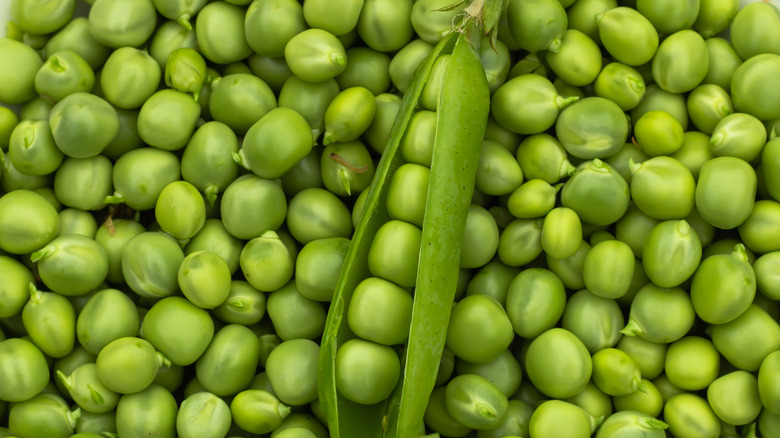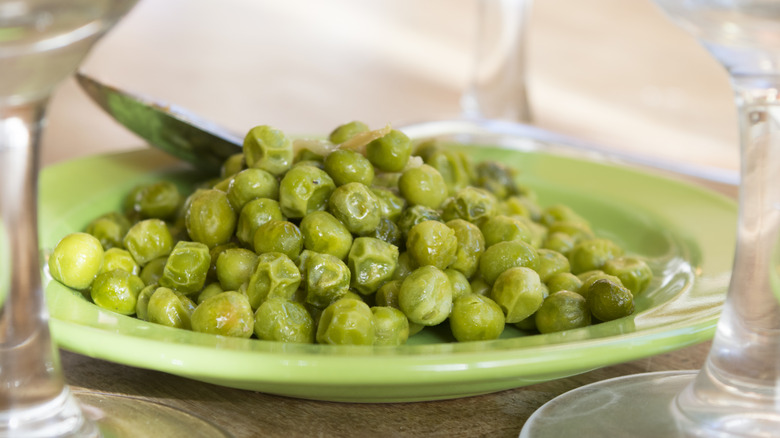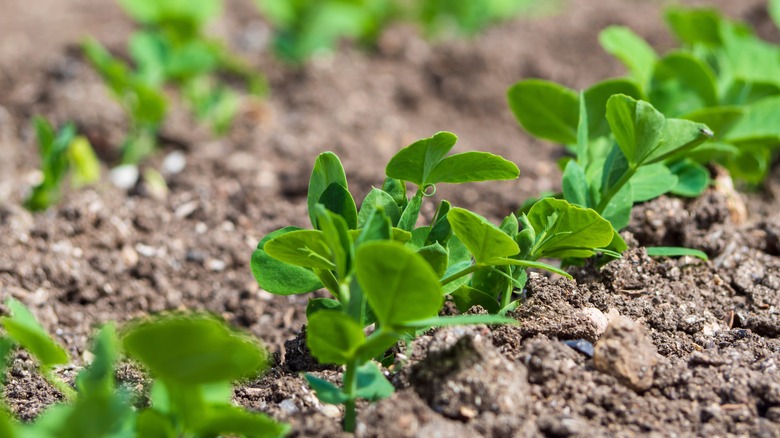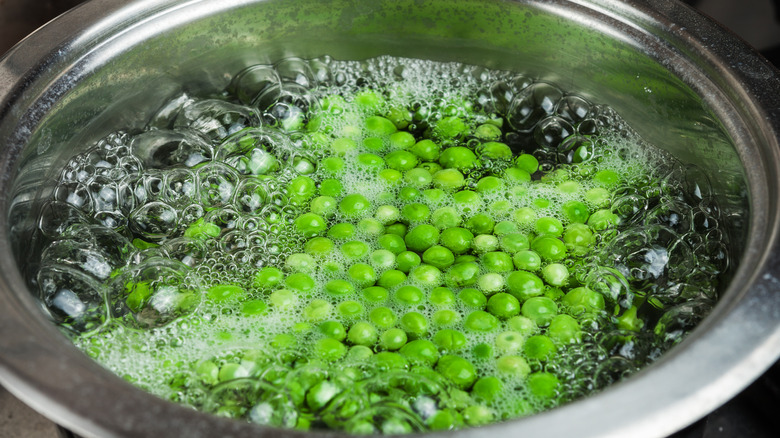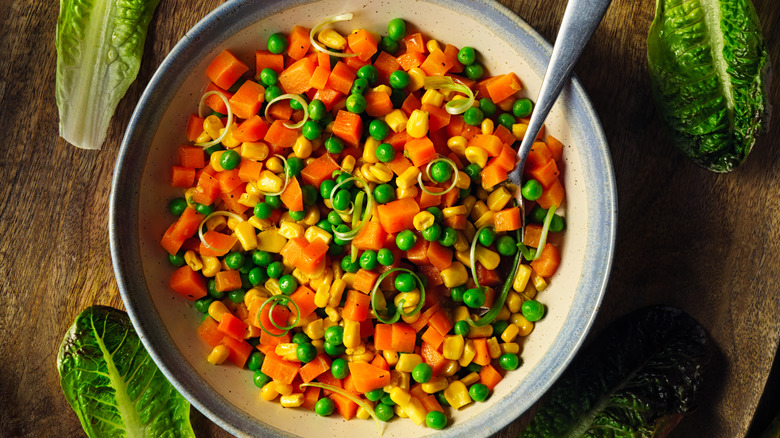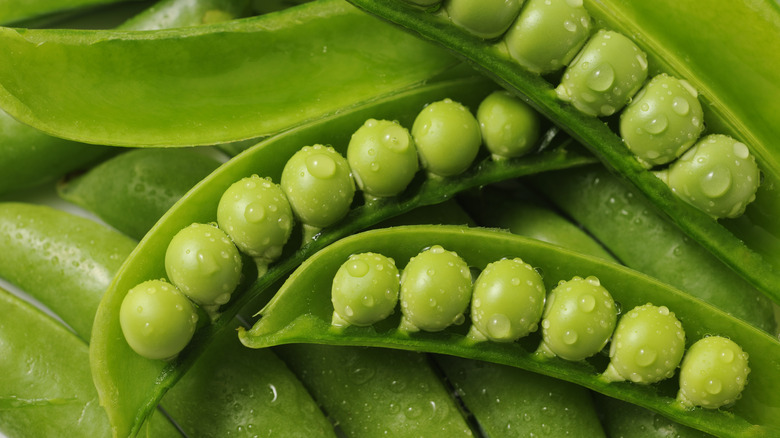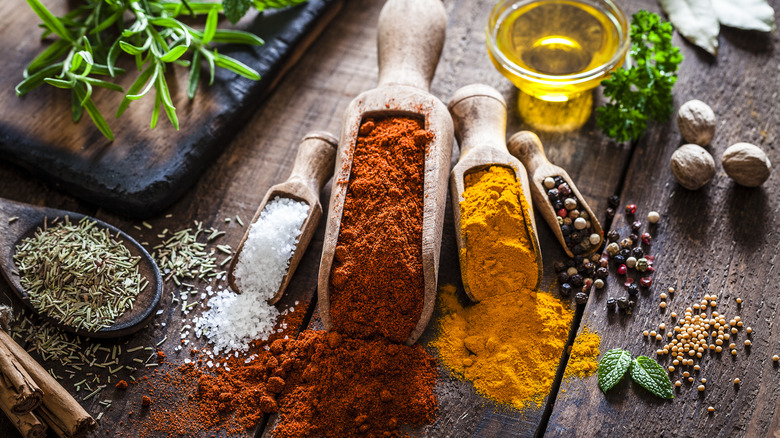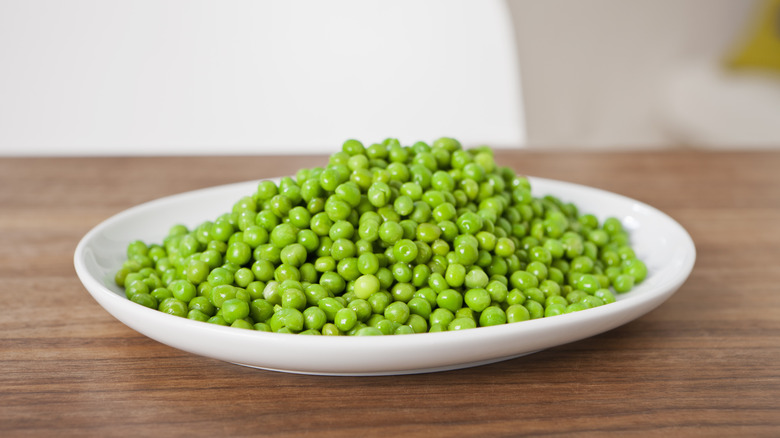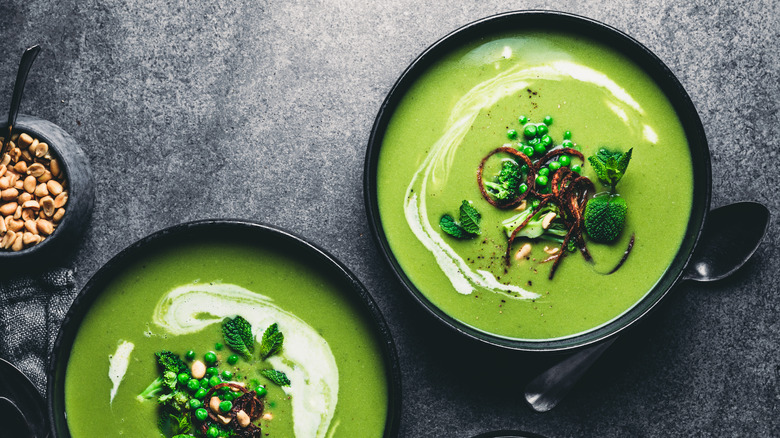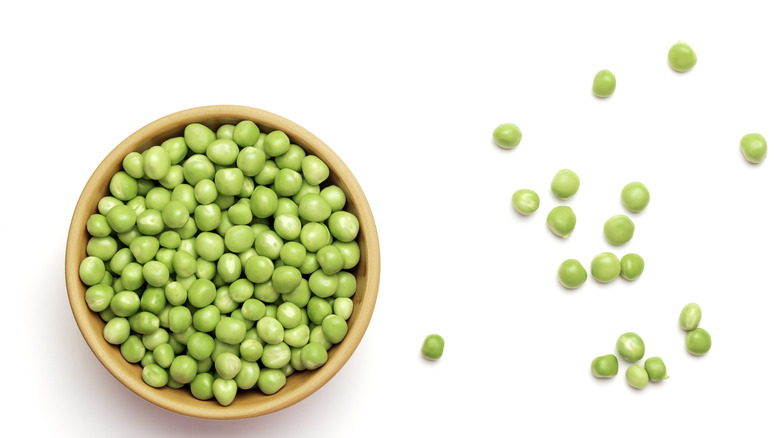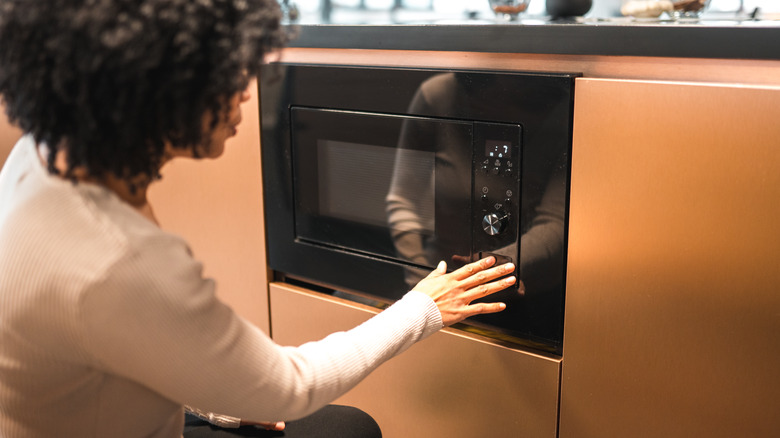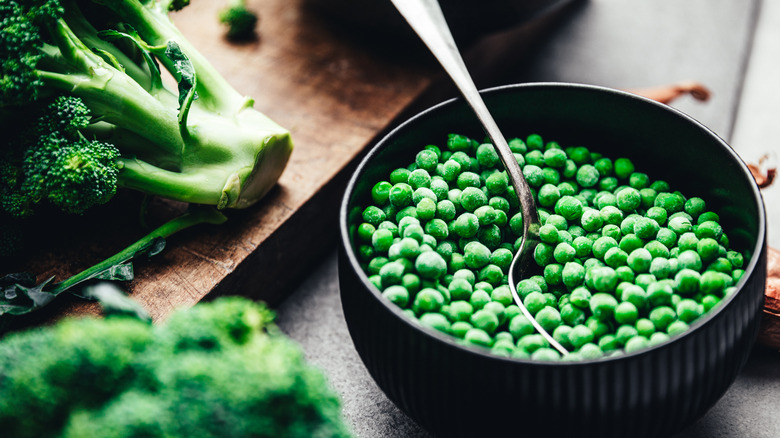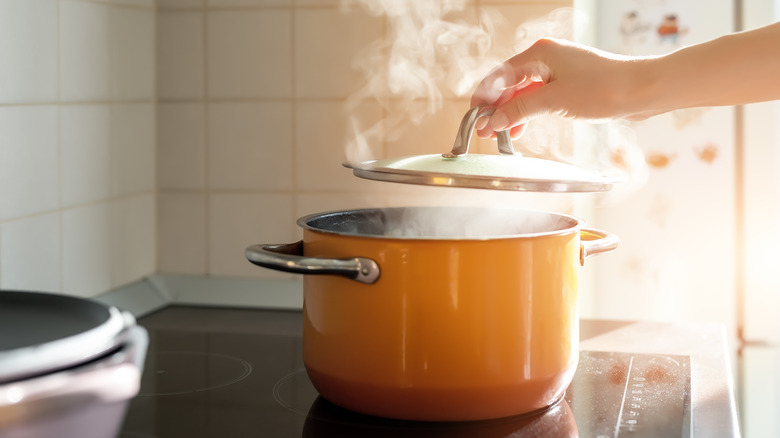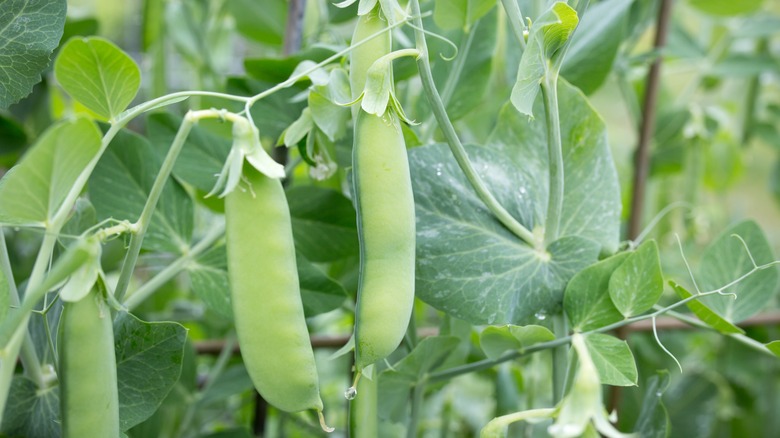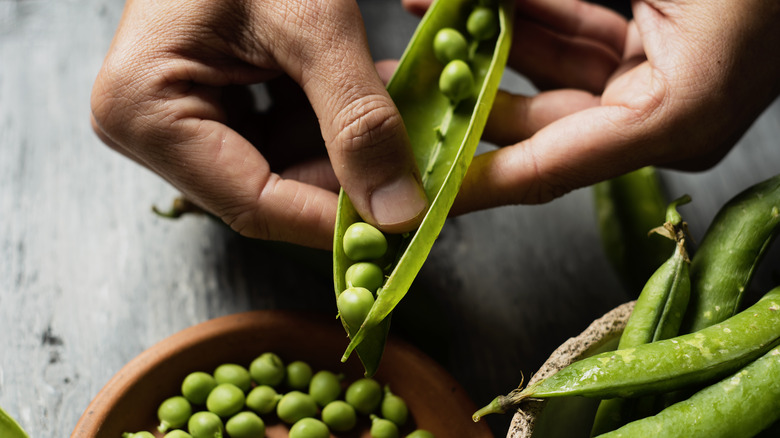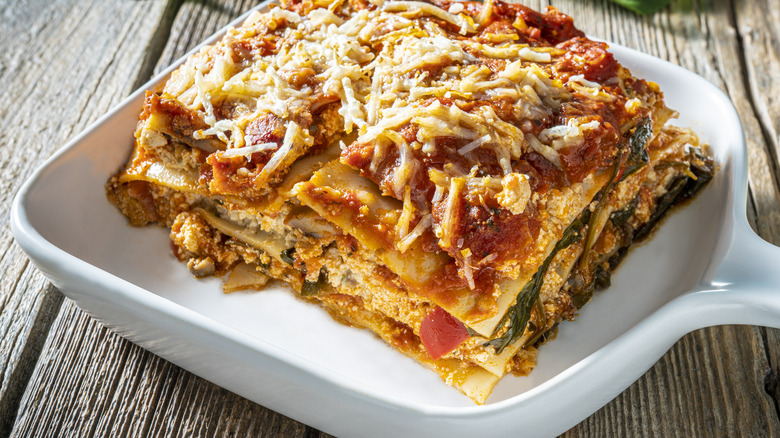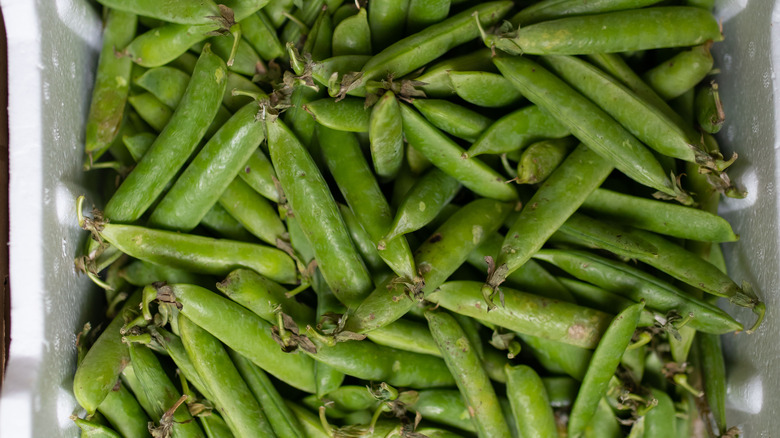15 Mistakes Everyone Seems To Make With Peas
Peas are one of those vegetables that are in just about everything. Fried rice, baby food, shepherd's pie, hot school lunches, stir-fries ... the list goes on and on. And the truth is that most people don't mind because they are easily palatable, mild in flavor, and quite sweet. In fact, when done right they can be quite a popular delicacy. Fresh peas can be found in spring salads, accompanying fresh cuts of meat, and featured in farm-to-table restaurants when they are in season. But unfortunately, they also have a bad rap when prepared incorrectly. Ever been served a steaming pile of soft, mushy, liquidy, yellow-green peas in a cafeteria? Avoid the mistakes everyone seems to make with peas, and let them reach their full potential.
Never again will you have friends or family picking around those little round green vegetables. Instead, they will be used only to enhance dishes, add flavor, and grab attention. Because of their beautiful aesthetic, peas can make quite an impression on a dinner plate. Learn to cook them the right way, and enjoy every last bite.
Overcooking them
One of the major mistakes everyone seems to make with peas is that they often get overcooked. This is what turns them from vibrant deep green to that putrid yellowy green. In addition, overcooked peas, depending on the cooking method, can be extremely dry, tough, and starchy, or mushy and soupy. Typically, the latter is an issue, leaving a textureless baby-food-like feel in your mouth. As adults, we shouldn't be subjected to such a mushy mess, at least not while we have all of our teeth.
If you're cooking peas from scratch, you can boil them but should set a timer for just a minute or two. The peas will continue to cook slightly when removed from the boiling water unless rinsed immediately with cold water. Your objective is to have them go from papery light green to a deeper darker hue. Once you've obtained that, the peas are done. They should still have structure to them, and even pop a little when you bite them. If the skin is shriveling, or they are turning yellow, then you've gone overboard.
Forgetting about the shoots
There's more to peas than just the little green pearls. The entire plant is quite beautiful, from the delicate white flowers to the curly tendrils. Once the pea plant grows pods and pods are removed, it's easy to forget about what else the plants have to offer. Sprouts and shoots have become all the rage, as they add aesthetic appeal and a whisper of freshness to every meal they garnish. They are concentrated with both flavor and nutrients, so why not indulge in pea shoots as well? For those of you who are questioning what pea shoots are, and how to eat them, listen up because the answer couldn't be simpler.
While pea sprouts are the little tendril that first grows out of a pea, the shoots are slightly different. They are a microgreen, meaning that they grow in soil, instead of being sprouted on a damp cloth or paper surface. They are used as garnishes and take a few weeks to grow. They are essentially the beginning of the pea plant forming before it reaches maturity. For those growing peas in your backyard, reserve some of the shoots to garnish your meals, and let the rest grow into mature pea plants. Don't forget to pair them with your pea-centric dishes!
Boiling frozen peas
Did you know that most frozen vegetables that you buy at the grocery store are already cooked? Most of them have at least been steamed, blanched, or parboiled in order to retain their texture after they've been frozen and defrosted. So when you bust open a bag of frozen peas and boil them in water, you're actually overcooking them. If you leave them in there long enough, you might even notice that they become quite starchy, or even break down. To avoid this, forget the boiling water altogether.
Instead, toss your peas in a hot pan with a little butter or extra virgin olive oil. Let them simmer just long enough until they are no longer frozen, and remove from the heat immediately. If you wish to season them, do so while they are still in the hot pan to give the herbs and spices a chance to toast and become fragrant.
Pairing them improperly
Plain peas. Peas with carrots. Peas with corn. Peas with carrots and corn. Why can America not think beyond these predictable combinations? Although peas taste fantastic accompanied by their two best friends, it's time to think outside of the box. Because peas have a mild and sweet flavor, they tend to pair well with just about any other vegetable, protein, and sometimes even fruit. For instance, peas can accompany seafood in dishes like grilled salmon, watercress, and pea salad. The trio offers different mouthfeels, textures, and flavorings while working together to create a unique dish that just flows.
Another example of peas pursuing versatility is when they work in tandem with fruit. For example, a summer strawberry salad with honey vinaigrette can be enhanced greatly by the addition of snap peas. In fact, because of their shared sweetness and ability to be eaten both raw and cooked, strawberries and peas work wonders together.
Always cooking them
Unless you grow peas fresh in your garden it's likely that you often buy, and enjoy cooked peas, whether at home or out to eat. And don't get us wrong, we love cooked peas, they are tender, bright, moist, and quite sweet. But the truth is that most people have never enjoyed a raw pea in their life, and we believe that they are missing out.
If you are able to get your hands on some fresh peas, you may have to do a little extra work. They are often sold in their pods, but shelling them isn't as arduous of a task as you might think. Simply start by rolling the pod between your fingers to aid them open, and loosen the pods. Once they are free, rinse them in cold water and enjoy them by the handful, in salads, or as a beautiful garnish. They are starchy, sweet, and slightly crunchy.
Eating them plain
Why do people always feel the need to serve peas plain Jane? The most common methods are boiled and steamed, but even a flavorful food like peas deserves to be dressed up a little. At the bare minimum, use a little butter to infuse the little green veggies with flavor, but extra virgin olive oil and sea salt work well too. To give peas cooked in olive oil the creaminess of peas cooked in butter, add a little nutritional yeast and let it dissolve in the liquid while the peas cook. Beyond salt and pepper basics, there are dozens of ways you can elevate your peas with spices.
For any green vegetable, a little tamari and lemon juice can go a long way. The acid of the lemon paired with the salty tamari creates a rounded mouthfeel when used in combination with sweet peas. For our more daring home chefs, consider adding a little sugar to enhance the sweetness of your peas, along with basics like salt, pepper, and garlic powder. Speaking of garlic, toss a little in the pan along with lemon and fresh parsley to bring out the more vegetable-like grassy qualities of the peas. When in doubt, use your favorite seasonings, you can't go wrong.
Thinking they're bland
On the other hand, plain peas are quite capable of carrying their own without a load of fresh herbs, aromatics, and spices. In fact, they have quite a unique flavor that makes them so incredibly desirable. Fresh peas, eaten raw are quite sweet with a deep green flavor, which depends on the variety and how soon they are picked after maturity. Peas that have been picked early are slightly grassier, while mature peas are loaded with natural sugars. Freshly picked peas have an entirely different range of sweetness to them than those that have sat in the grocery store for several days.
Cooked peas can also be eaten plain, and are known for their starchy, mild yet strong sweetness. Like corn, they become sweeter as the sugars are heated and are more easily digested by us humans. This is the preferred method of enjoyment, and while they have subtle spring-like undertones, a good, fresh pea should still carry quite a bit of flavor. If your peas are bland, it's likely you need to find a different source for them, like a local farm or vegetable stand if you're lucky enough to have one near you.
Never blending them
That little pop of sugary, starchy liquid that bursts when you bite into an al dente pea is oh-so-satisfying. But that doesn't mean we always have to enjoy peas in their pearl-like form. Blended peas can be used in a variety of ways and are much more versatile than we give them credit for.
Because they're so starchy, they can help to thicken soups. In fact, when blended they act similarly to potatoes, although are slightly less creamy, and tend to have a stronger sweet flavor, which can certainly work to your recipe's advantage. Be sure to steam or boil them before blending them in vegetable broth to create a green, creamy soup base. Be sure to flavor your base with plenty of herbs and spices, and to include a fat like butter or olive oil to accompany it. You can also add whole peas right into a soup to add flavor and texture, like in a healthy green soup, or a stew.
Believing you can undercook them
Some vegetables like potatoes, eggplant, or asparagus can be absolutely ruined if undercooked, leaving them stringy, fibrous, bitter, and even poisonous in some cases. Luckily, peas do not fall into that same category and have a full range when it comes to cooking requirements. In fact, they can even be eaten raw, which eliminates the fear that you can undercook them, depending on your desired outcomes.
If you're looking for a soft pea to blend into your dish without making a statement, then be sure to thoroughly cook them. The same goes for reheating frozen peas, they should be warm throughout, but not overcooked. Slightly blanched or heated peas can be incredibly delicious and will make more of a splash than their fully cooked friends. They will be a bit crunchier, starchier, and grassier, but not as intensely as the raw version. It's a great in-between for those looking for texture and aesthetic appeal.
Sticking to the microwave
It's so easy to throw fresh or frozen peas on a plate and let the microwave take care of the rest. After all, isn't that what the microwave is there for, convenience? Well, sometimes flavor trumps convenience and it's worth it to whip out a pan or pot to do your cooking. Especially when dealing with pre-cooked frozen peas, it's best to skip the microwave.
If you're planning on steaming your fresh peas in the microwave, do so with a microwave steamer. Simply submerging them in water and microwaving them until they boil can leave them overcooked. This is because if you were to boil peas on the stovetop, you would add them to already boiling water, and remove them shortly after. It's similar to the concept of pre-heating an oven or a stovetop pan. You want to add the food once it's hot, not let the food heat up with the air, water, or oil.
Believing they aren't very healthy
There is this misguided notion out there that starchy vegetables like peas, corn, and potatoes are unhealthy when in reality, they are an important part of a balanced diet. In fact, they are jam-packed with nutrients like fiber, vitamin C, and antioxidants. Peas in particular are high in protein, which makes an incredible plant-based source of the nutrient for vegans and vegetarians.
Peas are, in fact, one of those superfoods you should consider adding to your diet. They are heart-healthy, improve gut function, and can give you a boost of energy. Peas are optimal for athletes because of their low fat and high protein ratio. For a superfood, they aren't terribly expensive and are quite accessible for all. They are also a piece of cake to incorporate into your diet, as they pair well with just about anything. If you're seeking a healthier diet, then peas just may be your answer.
Not steaming them
There's a reason that corn, peas, and potatoes can be labeled as "unhealthy" and it typically has much more to do with how they are dressed than the actual vegetables themselves. Butter, mayonnaise, sour cream, and salt are often used beyond moderation to jazz up starchy vegetables. While it's tempting to douse veggies in oil and butter, there's a healthier option that's just as easy to prepare.
If you've never steamed vegetables, then you're missing out. Steaming is a step up from boiling and is a great way to retain moisture and nutrients. Steamer baskets are inexpensive and easy to use. Simply set them at the base of a pot, and fill water up to its base. Add your vegetables, and when the water boils, it will cook them in steam. When boiled, much of the vegetable nutrients are leached into the water, while with steaming much more of them are retained, making it one of the healthiest ways to cook veggies. Be sure to season your peas when they come out, cooked and bright green.
Limiting yourself to green peas
While green-shelled peas may be the talk of the town, there are plenty of other varieties of peas to experiment with. Variety is the spice of life, so why not take advantage of all peas have to offer? You may be familiar with some of the more common varieties like snap peas, snow peas, and shelling peas (which are the little green peas we remove from their pods). Even within each of these categories, there are different varieties. These peas, while all green, range in texture, shape, and flavor slightly.
While you can eat the shells of snap and snow peas, it's advised to remove the shell for shelling peas (hence the name) as it's quite fibrous and less pleasant to consume. If you've stuck to one variety your whole life, give the others a try. You may find that the sweetness and crunch of the snap peas or the tenderness of snow peas appeal to you more than your standard pea.
Tossing the pods
When it comes to vegetables, we never advise that you toss scraps, even if they are inedible. There are plenty of ways to use up your vegetable scraps from juicing them to making homemade vegetable broth. When shelling peas, the same rule applies. Yes, it might be easier to toss them into the garbage disposal, but those shells are full of nutrients and flavor, waiting to be used.
Even if you're not considering making vegetable brother soon, save the washed shells in your freezer. In fact, use a large freezer baggie to store all of your vegetable scraps, and just keep adding to it as you accumulate them. Then, when the bag is full and you've found yourself twiddling your thumbs on a rainy day, throw those frozen scraps into boiling water along with a little tomato paste and seasoning, and enjoy fresh broth. If you're not going to use it right away, freeze it in an ice cube tray, or in individual cup servings using a muffin tin. Crack the vegetable broth cubes free and keep them stored in a freezer bag with the date that you froze them. Defrost homemade vegetable broth as needed.
Excluding them from sauces and spreads
Peas are incredibly starchy, so they make for a perfect spread. You've likely heard of bean spread, so why not make a pea spread? Simply cook your peas and then blend them in the food processor until they are creamy and smooth. Add your favorite herbs, spices, olive oils, and cheese, and get dipping. In fact, you should be adding peas to your basil pesto recipe to add a little bulk and make it more hearty and spreadable.
Ever heard of vegan ricotta? Although it might sound like an oxymoron, it's actually quite delicious and easy to make. It's also a great option for your vegan, and lactose-intolerant friends and family members. Use a food processor to blend peas, firm tofu, cashews, lemon juice, pressed garlic, and basil. Blend it long enough so that it has the consistency of ricotta, and use it in your lasagnas, dolloped on pasta, or spread it into sandwiches.
Forgetting to string snap peas
There are plenty of culinary no-nos out there, like leaving the fibrous ends on asparagus, removing duck fat, and smashing your pancakes down with the spatula while they cook. Another taboo to look out for is leaving the little fibrous thread on snap peas. While it won't kill anyone, it's never pleasant to endlessly chew or pick out of your teeth. And while most peas are quite simple to prepare, it's worth the extra step to remove the little strands.
The absolute best way to string snap peas is by using a paring knife or your fingers to make a little "U" shape cut at the top of the pod. Then, place your thumb in the cut, and peel the very tip of the pod down towards the base. Little wirey strands from either side of the shell should follow your thumb. Do this on both sides, and you should be left with a tender and entirely edible pod.
